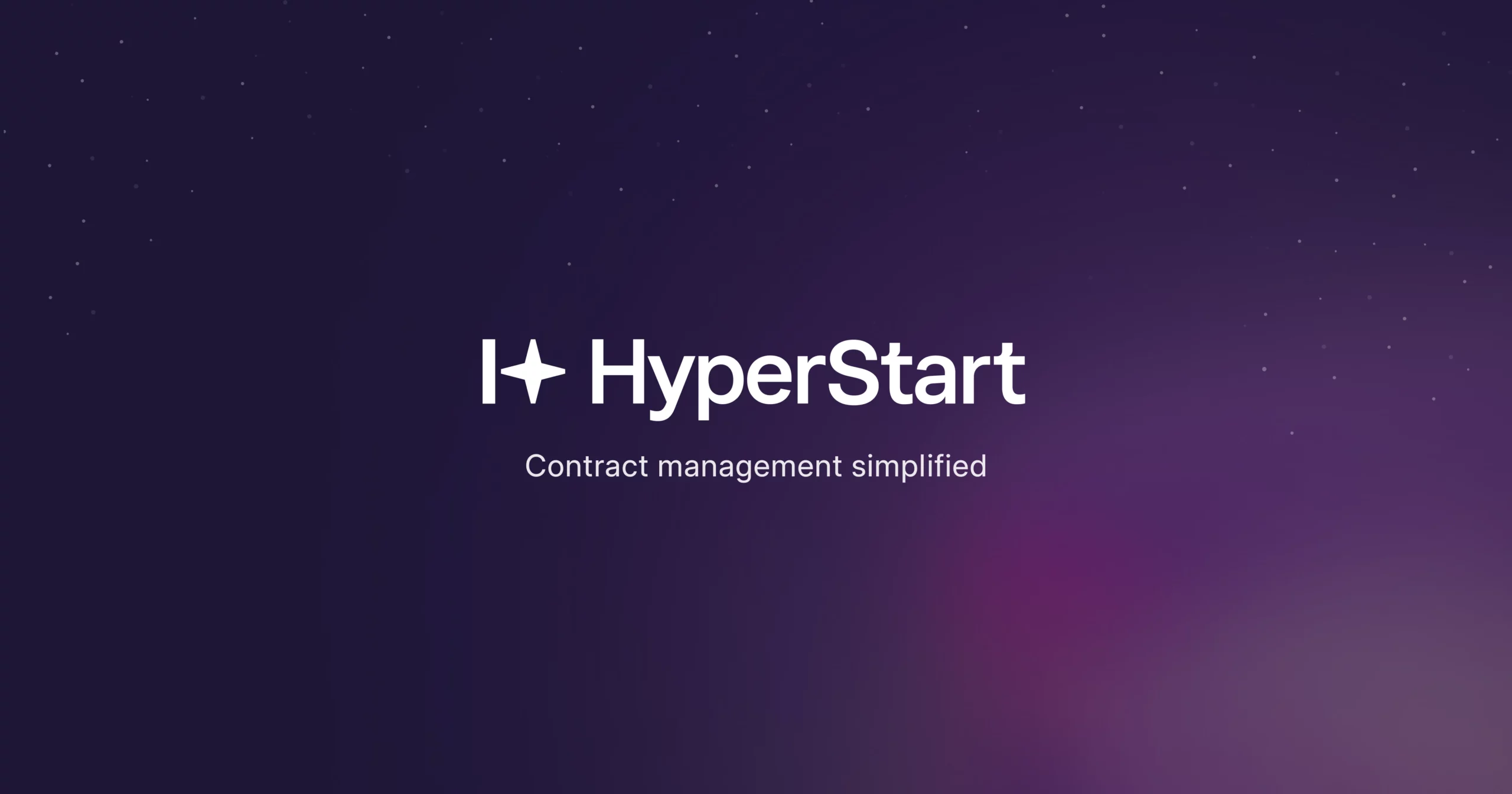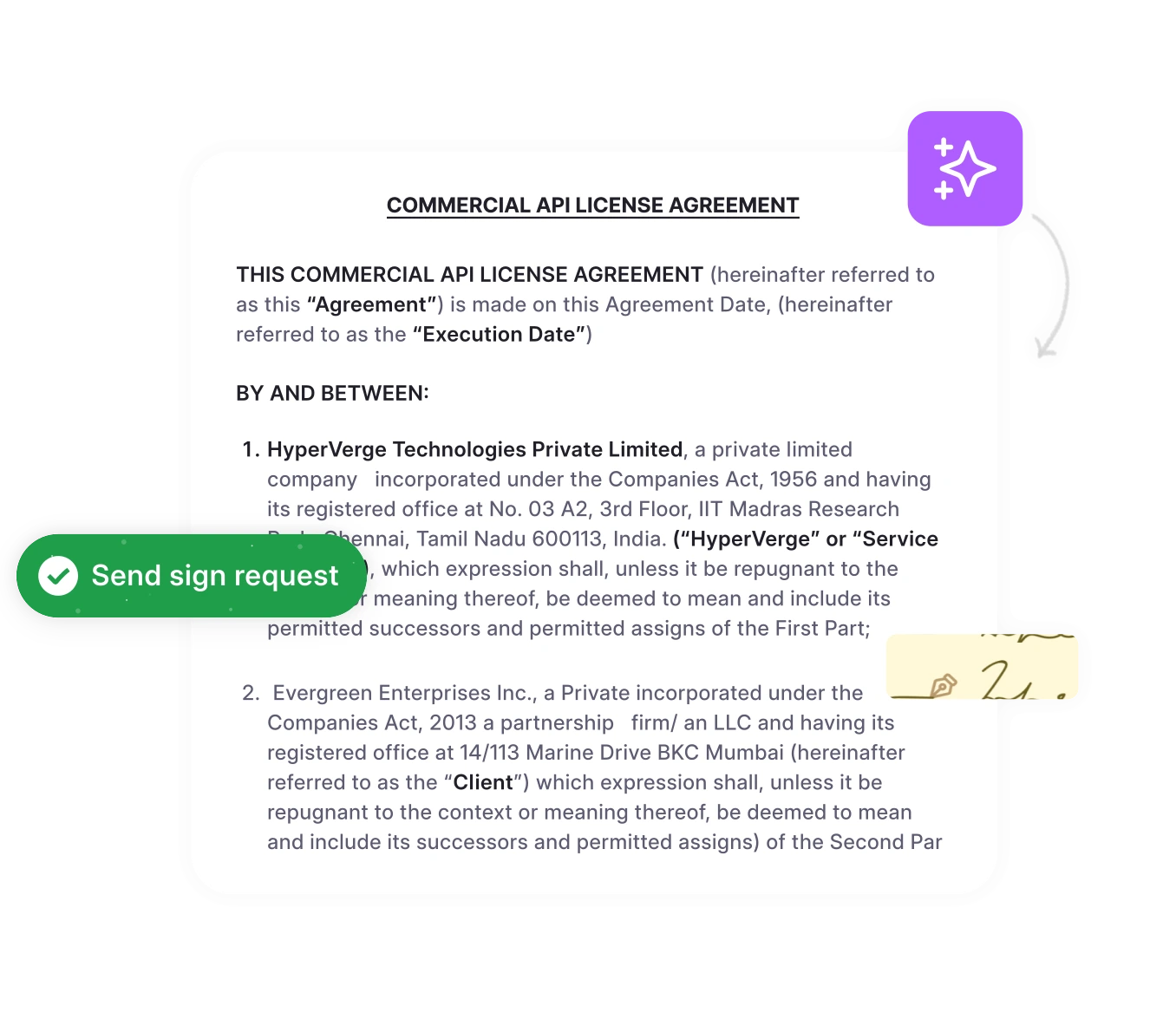The solution to delayed contract negotiations and trivial contract disputes is smarter contracting through standardization. Companies that adopt standardized contracts experience faster contract cycles, fewer disputes, and reduced legal overhead. Yet, most organizations struggle with where to start and how to implement standardization effectively. This comprehensive guide will walk you through everything you need to know about standardized contracts: what they are, when to use them, how to create effective templates, and the role of CLM software in standardizing contracts.
Whether you’re a legal professional, procurement manager, or business leader, you’ll discover actionable strategies to transform your contract processes from chaotic to streamlined.
What are standardized contracts?
Standardized contracts are pre-approved legal agreements with predetermined terms and conditions that require minimal or no negotiation between parties. These contracts operate within the framework of the Uniform Commercial Code (UCC) and other applicable laws that govern contractual commercial relationships. Also known as standard form contracts, boilerplate contracts, or template agreements, these documents streamline the contracting process by establishing consistent terms across similar transactions.
The key characteristics that define standardized contracts include:
- Non-negotiable terms: Most clauses are fixed and cannot be altered by the counterparty. This “take it or leave it” approach eliminates lengthy negotiations on standard provisions.
- High-volume usage: These contracts are designed for transactions that occur frequently across your organization, such as vendor agreements or employment contracts.
- Low risk profile: Standardized contracts typically govern lower-risk, routine business activities where the potential exposure is manageable and predictable.
- Minimal customization: While some fields may be variable (names, dates, amounts), the core legal framework remains consistent across all agreements.
The primary differences between standardized and custom contracts lie in their flexibility and complexity.
While custom contracts are tailored to specific, often high-value or complex transactions, standardized contracts prioritize efficiency and consistency over customization. This makes them ideal for scaling businesses that need to execute numerous similar agreements without reinventing the wheel each time.
Having understood what standardized contracts are, let us now explore the different types and most common examples of these contracts.
What are the different types and examples of standardized contracts?
Understanding when and where to apply contract standardization is crucial for maximizing its benefits. Here are the most common types across different business sectors:
Types of standardized contracts
| Industry Sector | Common Contract Types | Key Characteristics |
| Software & Technology | SaaS agreements, API usage agreements, and Data processing agreements | High complexity, multiple integrations, and consistent risk allocation needs |
| Professional Services | Master Service Agreements (MSAs), Non-disclosure agreements (NDAs), Consulting agreements | Foundational relationship terms, high-velocity sales environments |
| Employment & HR | Employment contracts, Non-compete agreements, Option agreements | Brand consistency requirements, standardized company values |
| Commercial Transactions | Vendor agreements, Purchase order forms, Terms of service | Multiple supplier relationships, compliance management needs |
| Real Estate & Leasing | Rental property agreements, Property management contracts | Scale operations, property-specific customization within a standard framework |
Examples of standard contracts
Let’s examine specific real-world applications where contract standardization delivers maximum value:
1. SaaS agreements
It represents one of the most successful applications of contract standardization. Given the complexity of software licensing, data usage provisions, and liability terms, standardization prevents chaos while ensuring consistent risk allocation. Companies like Microsoft and Salesforce use standardized SaaS agreements across thousands of customer relationships, allowing for rapid deployment while maintaining legal protection.
2. Master Service Agreements (MSAs)
MSAs are prime candidates for standardization, especially in high-velocity sales environments. These agreements establish the foundational terms governing client relationships, allowing individual project contracts to reference the standardized framework. Consulting firms and professional services companies rely on standardized MSAs to accelerate client onboarding while ensuring consistent risk management.
3. Non-disclosure agreements (NDAs)
NDAs are perhaps the most universally standardized contract type, as they typically protect one party’s interests with little wiggle room in the negotiation process. Whether for employee onboarding, vendor relationships, or partnership discussions, standardized NDAs enable quick execution while providing reliable confidentiality protection.
4. Vendor agreements
Vendor agreements require standardization to manage multiple supplier relationships effectively. Without consistent terms, managing vendor performance and compliance becomes exponentially more complex. Large corporations typically maintain standardized vendor agreement templates that cover payment terms, delivery requirements, and compliance obligations.
The American Institute of Architects has developed a collection of standardized documents that establish clear relationships and terms among stakeholders like owners, contractors, architects, and engineers in construction projects.
Read more about it on our blog on AIA contracts .
Standardize contracts for faster reviews
HyperStart accelerates the contract redlining process while ensuring all clauses align with your approved templates and playbooks.
Book a DemoWhile standardized contracts offer various forms and applications, it is also important to consider the difficulties that can arise when such standardization is absent.
What challenges arise without contract standardization?
Organizations operating without standardized contracts face predictable but serious operational challenges that compound over time. Here are the top 5 problems that emerge:
1. Erratic contract language and terms
When different departments create their own agreements, you end up with conflicting obligations and inconsistent risk allocations across similar contracts. Marketing might agree to terms that finance would never approve, while procurement uses different provisions for liability caps than sales. This inconsistency becomes a nightmare during contract audits or disputes when you discover that similar relationships are governed by completely different terms.
2. Endless negotiation cycles
Every custom contract requires drafting from scratch and extensive legal document review, which is a bottleneck for business operations. Sales opportunities stall while contracts sit in legal queues, procurement can’t onboard vendors quickly, and strategic partnerships take months to finalize. Under pressure to close deals, business teams often agree to problematic terms just to speed up the signature process.
According to the Amazon vendor negotiation study, annual Vendor Negotiations continue to be time-consuming for brands. 69% of vendors expect 2025 negotiation cycles to last between 1 and 3 months, while 18% expect a negotiation length of 3 to 4 months.
3. Compliance risks from rogue contract clauses
Non-legal personnel modifying contracts without proper oversight create serious liability exposure. A sales rep might agree to unlimited liability to close a deal, or a procurement manager could accidentally waive important intellectual property protections. These unauthorized changes can violate corporate policies, conflict with regulatory requirements, or expose your organization to unexpected legal risks that surface only during disputes.
4. Administrative burden on legal
Legal teams spend their time on routine contract drafting instead of strategic work that drives business value. Every vendor agreement, employment contract, or service agreement consumes valuable legal hours that could be focused on complex deals, risk analysis, or business development. This creates a vicious cycle where legal capacity constraints further slow down business operations.
5. Version control nightmares across contract types
Multiple variations of similar contracts make it impossible to track which terms apply to which relationships. When renewal time comes or disputes arise, you’re left scrambling to determine what was actually agreed upon. Contract databases become cluttered with dozens of “standard” agreement versions, and nobody knows which template to use for new deals or how terms have evolved over time.
Having discussed the difficulties that arise in the absence of contract standardization, let’s now turn to the advantages that standardization brings to contractual agreements.
What are the benefits of contract standardization?
Implementing standardized contracts transforms how organizations handle legal agreements, moving from chaotic, time-consuming processes to streamlined, efficient operations.
Legal Ops: Track bottlenecks by department
General Counsel: Maintaining compliance while accelerating approvals
Finance: Risk-based approval thresholds that protect margins
Procurement: Vendor contract approval automation
Here are the top 5 benefits of contract standardization:
1. Faster legal reviews
Every custom contract requires legal review, creating bottlenecks that slow down business operations. With standardized contracts, legal teams review and approve templates once, then business units can execute agreements without waiting for legal input on routine terms. This means sales teams can close deals faster, procurement can onboard vendors quickly, and HR can hire employees without lengthy contract negotiations.
2. Consistent risk management and compliance
Different contract terms across similar agreements create compliance headaches and unpredictable risk exposure. Standardized contracts establish uniform liability provisions, dispute resolution mechanisms, and regulatory compliance requirements across all agreements. When audit time comes or disputes arise, you know exactly what terms apply and can demonstrate consistent adherence to corporate policies and industry regulations.
Third-party and contract risk management is critical for complex vendor ecosystems. Forbes reports that approximately 60% of data breaches in large organizations in the past year involved outsourced vendors.
3. Reduce contract administration overheads
Drafting custom contracts from scratch consumes valuable legal resources that could be focused on strategic work. Standardized templates eliminate repetitive drafting, reduce negotiation cycles, and minimize the need for legal involvement in routine transactions. Legal teams can shift their focus from administrative contract work to high-value activities like complex deal structuring, risk analysis, and strategic business partnerships.
4. Accelerated deal closure
Lengthy contract negotiations over standard terms slow down business development and frustrate potential partners or customers. With standardized contracts, counterparties know what to expect, negotiations focus only on key commercial terms, and deals close faster. Sales teams can provide immediate contract terms to prospects, while procurement can quickly engage new suppliers without extended legal discussions.
5. Scalable growth
Growing businesses often find that contract volumes increase faster than legal team capacity, creating operational constraints. Standardized contracts allow organizations to scale their contracting activities without proportionally increasing legal headcount. As you expand into new markets or launch new products, standardized templates provide the foundation for rapid growth while maintaining consistent legal protection and risk management.
Bring consistency to every contract you sign
HyperStart helps your team review third-party agreements, detect deviations from your standards, and enforce uniform language across deals.
Book a DemoAfter exploring the advantages that contract standardization offers, it is essential to understand the practical steps involved in developing effective standard contract templates.
How to create standard contract templates?
Creating effective standardized contract templates requires a systematic approach that balances legal protection, business needs, and operational efficiency. Here are the essential 7 steps to get you started:
Step 1. Decide which contracts to standardize
Before diving in, define objectives. Which contracts do you use most often and at what scale? Are there agreements that require too much repetitive manual work? Answering these questions helps identify the best candidates for standardization. Focus on simple contracts, high volume, low value, and low risk—these deliver the biggest impact with the least complexity.
Step 2. Analyze current contracts
Gather all versions of each contract type—say, an MSA or NDA—and identify the common elements between them. Are there clauses that are seldom negotiated? Contract terms that are frequently redlined? This analysis reveals what should be standardized versus what needs flexibility, giving you a clear framework for template development.
Step 3. Simplify contract language
The key to successful contract templates is simplicity. Your contract terms need to be straightforward, concise, and jargon-free while still covering all legal bases. Remove anything likely to cause confusion or lengthy explanations. Consider using tables and visual elements to make complex terms easier to understand, improving both readability and adoption rates.
Step 4. Balance standardization and flexibility
Standardized contracts work best for largely non-negotiable transactions, but your terms should still be fair for both parties. Identify which terms are truly non-negotiable versus where limited flexibility might accelerate deal closure.
Step 5. Build your contract template
Once you’ve determined what to include, create your master template with proper legal review and stakeholder input. Apply your company’s workflow standards, brand standards and design elements to maintain consistency. Gather feedback from everyone who will use the template—legal, sales, procurement, and operations—to ensure it works for all stakeholders.
Flowcharts are useful for clauses that describe processes where different decisions determine possible alternative outcomes (e.g., price change, change management, complaint escalation, remedies to contract breach).
Step 6. Roll out the new standardized contracts
Training and enablement are critical for successful adoption. Educate stakeholders on what each template contains, what the contract clauses mean, and what flexibility is available. Provide clear guidelines on when to use each template and when to escalate for custom agreements. Document approval processes and ensure everyone knows how to access and execute the standardized contracts.
Step 7. Create automated workflows and governance
Once templates are finalized, establish automated contract drafting, approval routing and signature processes that guide contracts from creation through execution. Implement governance controls that prevent unauthorized template modifications while allowing for periodic updates based on legal requirements or business needs. This ensures your standardization program remains effective and compliant over time.
With standard contract templates in place, the next step is to leverage CLM software to automate, manage, and optimize these contracts throughout their lifecycle.
How does HyperStart CLM create standardized contracts?
Modern Contract Lifecycle Management (CLM) platforms turn standardized contracts into dynamic business tools that enhance operational efficiency, maintain compliance, and reduce risk.
The automated approval workflows and the AI feature that helps easily identify essential clauses in the contract. The team is also incredibly responsive and provides clear, actionable solutions that feel tailored to our needs.
1. Template management and standardization
CLM systems maintain libraries of approved templates with version control, ensuring teams always use the latest and compliant versions, while maintaining consistency across the contract portfolio.
2. Automated approval workflows
Predefined approval workflows route contracts based on type, value, or risk, eliminating manual delays. This automation can be ad hoc or sequential, speeding up contract execution in case stakeholders aren’t available.
3. AI-Powered contract intelligence
Advanced CLM platforms extract metadata from contracts, analyze clause performance, and detect potential risks. AI-driven insights reveal which standardized clauses deliver better outcomes, highlight emerging risks, and enable optimization.
4. Seamless system integration
Integration with email, Slack, Teams, and digital signature tools accelerates contract approvals and execution. All stakeholder teams can collaborate with maximum efficiency with accurate, up-to-date information.
5. Process tracking and optimization
CLM software monitors pre-execution process metrics like approval time, turns taken, contract status so deals are closed faster. Automated alerts, performance tracking, and audit-ready records improve accountability and reduce the risk of breaches in standardized contracts.
Benchmark contract processes
With AI-powered analysis, HyperStart detects variations in indemnities, SLAs, and termination clauses, so every contract meets your standards.
Book a DemoUse the power of standardized contracts with HyperStart
To improve efficiency and reduce the legal and compliance risks of standardized contracts, focus on high-volume, low-complexity agreements first. Build reliable templates with legal approval, and keep them updated to reflect business and regulatory changes.
Modern CLM platforms like HyperStart make this process seamless with contracting best practices. With AI-powered contract intelligence, automated workflows, and smart analytics, HyperStart transforms standardized contracts from routine paperwork into strategic assets that enhance compliance, speed, and overall business performance.












